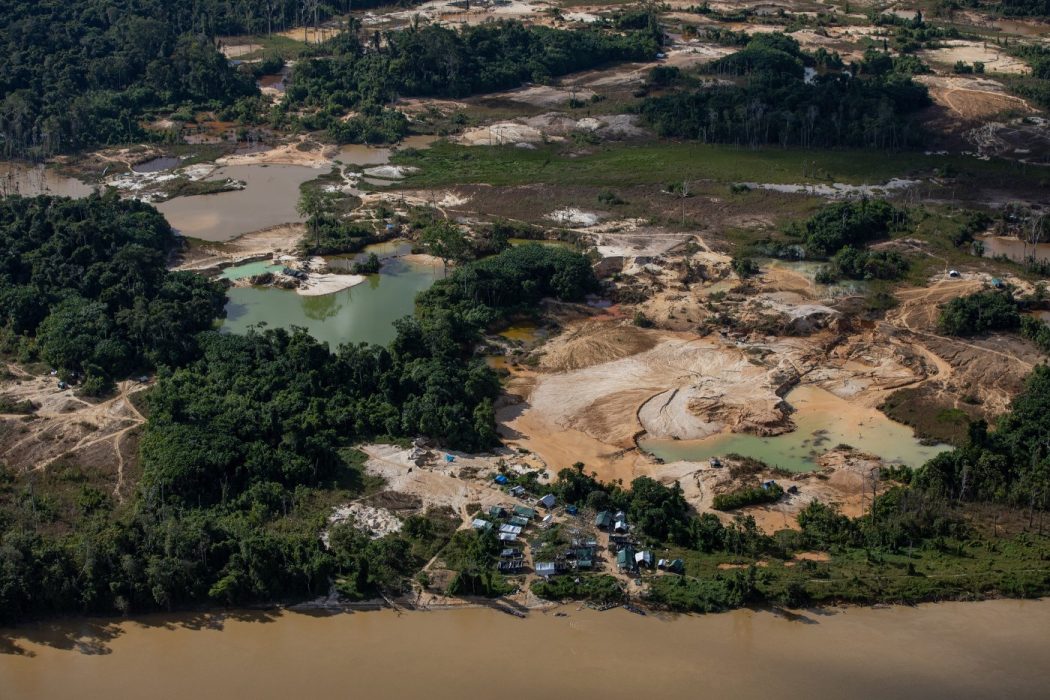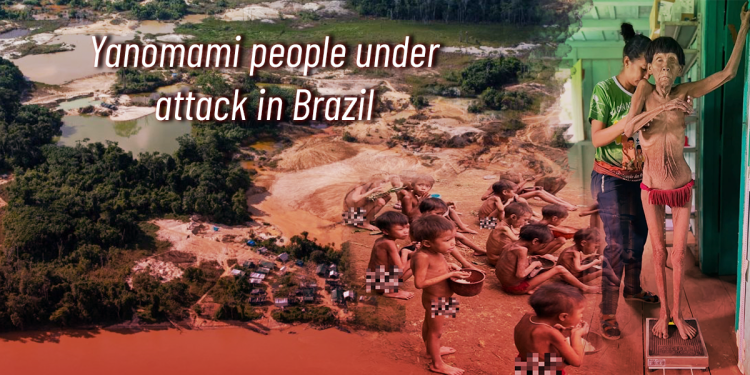BRAZIL – The Hutukara Associação Yanomami (HAY) launched 11/04 the report “Yanomami Under Attack: Illegal Mining in the Yanomami Indigenous Land and Proposals to Combat it – an overview of the advance of mining destruction in the largest indigenous land in the country.” With an area equivalent to Portugal, spread over the states of Roraima and Amazonas, the Yanomami Land completes 30 years of demarcation on May 25, 2022. At the time of the decree, the territory was overrun by illegal mining.
Today, the torturers remain the same, but with a much greater power of destruction. “The attack on the people of the Yanomami Indigenous Land already occurred in the 1980s, with the invasion of more than 40,000 miners. Today, in 2022, history repeats itself. This is very serious”, warns Dario Kopenawa, vice-president of the Hutukara.
Due mainly to the increase in the price of gold on the international market and government support for illegal activity, mining is advancing rapidly, causing deforestation, disease and death wherever it goes.
The document denounces several attacks by criminals against indigenous communities and provides a complete chronology of the siege of Palimiu in 2021 – a region where the group Primeiro Comando da Capital (PCC) has a strong presence.
According to data extracted from the report, in 2021 illegal mining advanced 46% compared to 2020. Last year, a jump of 30% had already been registered in relation to the previous period. From 2016 to 2020, mining in TIY grew by no less than 3,350%, the Hutukara study points out.
Also according to the document, the number of communities directly affected by illegal mining totals 273, covering more than 16,000 people, or 56% of the total population. There are more than 350 indigenous communities in the Indigenous Land, with a population of approximately 29,000 people.
“The illegal extraction of gold [and cassiterite] in Yanomami territory has brought an explosion in cases of malaria and other infectious diseases, with serious consequences for the health and economy of families, and a frightening upsurge in violence against indigenous people,” says the Hutukara.
In fact, as the report shows, malaria has exploded in areas of strong mining activity, such as in the regions of Uraricoera, Palimiu and Waikás. In Palimiu, in 2020, there were more than 1,800 cases.
“It is noteworthy that the total population of Palimiu in the same year was just over 900 people, that is, the data point to an average of almost two [contaminations by] malaria per person,” the text highlights.
At the beginning of the monitoring, in October 2018, the total area destroyed by mining totaled just over 1,200 hectares, with most of it concentrated in the Uraricoera and Mucajaí rivers. Since then, the impacted area has more than doubled, reaching a total of 3,272 hectares by December 2021.
The growth was accentuated mainly from the second half of 2020, coinciding dangerously with the resurgence of the Covid-19 pandemic. In 2021 alone, there was an increase of more than 1,000 hectares.
According to the document, of the 37 health centers existing in the Indigenous Land, 18 have a record of deforestation related to mining. A recent photo taken by the vice-president of the Hutukara, of the structure of the Basic Indigenous Health Unit (UBSI) of Homoxi being swallowed up by a crater caused by mining, generated a great deal of repercussion in the press and social media.

Aerial recordings made by the Hutukara for the report in late January 2022 also show the increasing proximity of mining to indigenous communities, in addition to immense scars in the forest, pollution of rivers, and the flagrant sighting of aircraft, helicopters, and other high-value equipment used in the illegal activity.
“The government needs to evaluate its actions, because many operations to combat illegal mining have had no effect. This document shows the reality that we are living and its consequences, of much violence and vulnerability. My people are suffering. We ask for the support of the population to join our cry for help for the immediate withdrawal of the miners from our territory”, Dario Kopenawa said.
The document ends with a series of recommendations to the government and emphasizes that mining is not a problem without a solution, but requires political will to ensure efficient and coordinated action by the state and coordination among the responsible agencies and agents.
Main factors for the jump in illegal mining on Yanomami land
- Rising gold prices on the international market
- Lack of transparency in the gold production chain and regulatory failures that allow fraud in the declaration of origin of the illegally extracted metal
- Weakening of environmental policies and protection of indigenous peoples’ rights and, consequently, of the regular and coordinated inspection of illicit activity on Indigenous Lands
- Aggravation of the economic crisis and unemployment in the country, producing a mass of cheap labor to be exploited in highly precarious and dangerous conditions
- The current government’s policy of insistent encouragement and support for the activity despite its illegal character, thus producing the expectation that the practice will be regularized.
Situation of the Yanomami children of Kataroa, Surucucu region, Alto Alegre municipality. The children are suffering from severe malnutrition in addition to other diseases such as malaria. This is the result of the advance of mining and the lack of assistance from the DSEI. The case was shared by the Urihi Associação Yanomami;
 New images show Yanomami children suffering from severe malnutrition in the Yanomami Indigenous Land, the largest indigenous reserve in the country. The photos, released by the Urihi association, reveal extremely thin boys and girls with apparent ribs, a dramatic situation similar to that denounced by Fantástico and g1 in November last year.
New images show Yanomami children suffering from severe malnutrition in the Yanomami Indigenous Land, the largest indigenous reserve in the country. The photos, released by the Urihi association, reveal extremely thin boys and girls with apparent ribs, a dramatic situation similar to that denounced by Fantástico and g1 in November last year.
This time, the photos that denounce and expose the abandonment of Yanomami health are of children who live in the Kataroa community, Surucucu region, in the municipality of Alto Alegre, in the north of Roraima. The images were shown by GloboNews on Friday (9). The public health problem is directly related to the invasion of miners in the indigenous reserve.
After malaria, child malnutrition is one of the greatest health problems faced by the indigenous people of Yanomami land. A study by UNICEF (the children’s arm of the United Nations) and Fiocruz indicates that eight out of ten children under the age of five have chronic malnutrition – in the Auaris and Maturacá regions.
In November, the Federal Police and the Federal Public Ministry (MPF) carried out an operation against a fraud in the purchase of medicines destined to the Special Indigenous Health District Yanomami (Dsei-Y).
According to the investigations, the criminal scheme left at least 10 thousand indigenous children without medicine. The targets of the operation are businessmen and employees of the Dsei-Y – the body of the Ministry of Health responsible for Yanomami indigenous health.
The investigations indicate that the two coordinators, during their respective administrations, signed a contract with Balme for the supply of 90 types of medicines. However, the company delivered less than 30% of what was expected. The scheme had the participation of servers linked to them and the owner of the contracted company. The PF estimates that the embezzlement scheme has moved R$600 thousand. The unit is the same one that, in March of this year, had its structure threatened due to the proximity of an open-air crater caused by the advance of mining activity.
In addition, the indigenous people suffer from precarious health care – largely aggravated by illegal mining. On Tuesday (6), the Basic Indigenous Health Unit of Homoxi (UBSI) in the Homoxi region of the Yanomami Indigenous Land was set on fire.
“Illegal miners burned down our Yanomami health post in the Homoxi region!” said Dario Kopenawa, vice president of the Hutukara.
According to Urihi, the fire was caused by illegal miners. The Hutukara Associação Yanomami, the most representative organization of the Yanomami people, also released images of the burned out post and stated that the fire was caused by invaders. Urihi’s suspicion is that the fire was in retaliation against Operation Guardians of the Biome, by Ibama, with the participation of the Federal Police, which is fighting illegal mining and other environmental crimes in the Indigenous Land. The inspection is ongoing and has already burned the planes used by miners.




